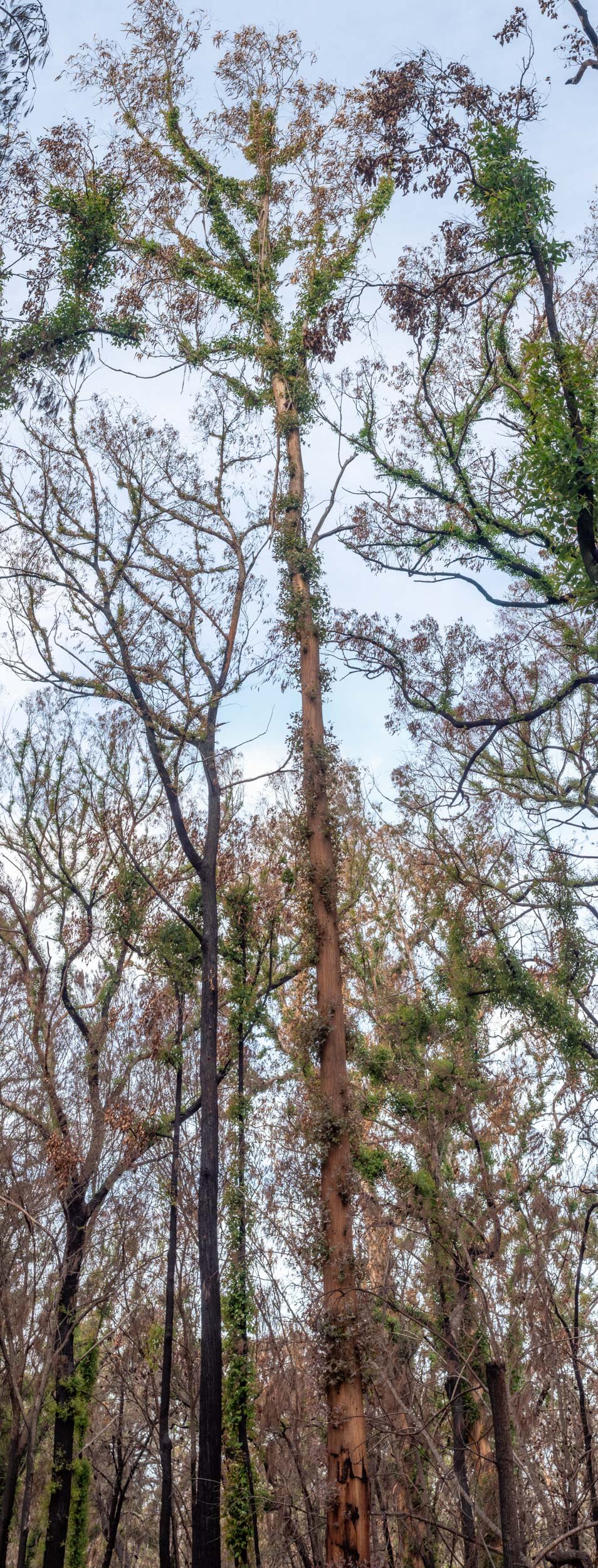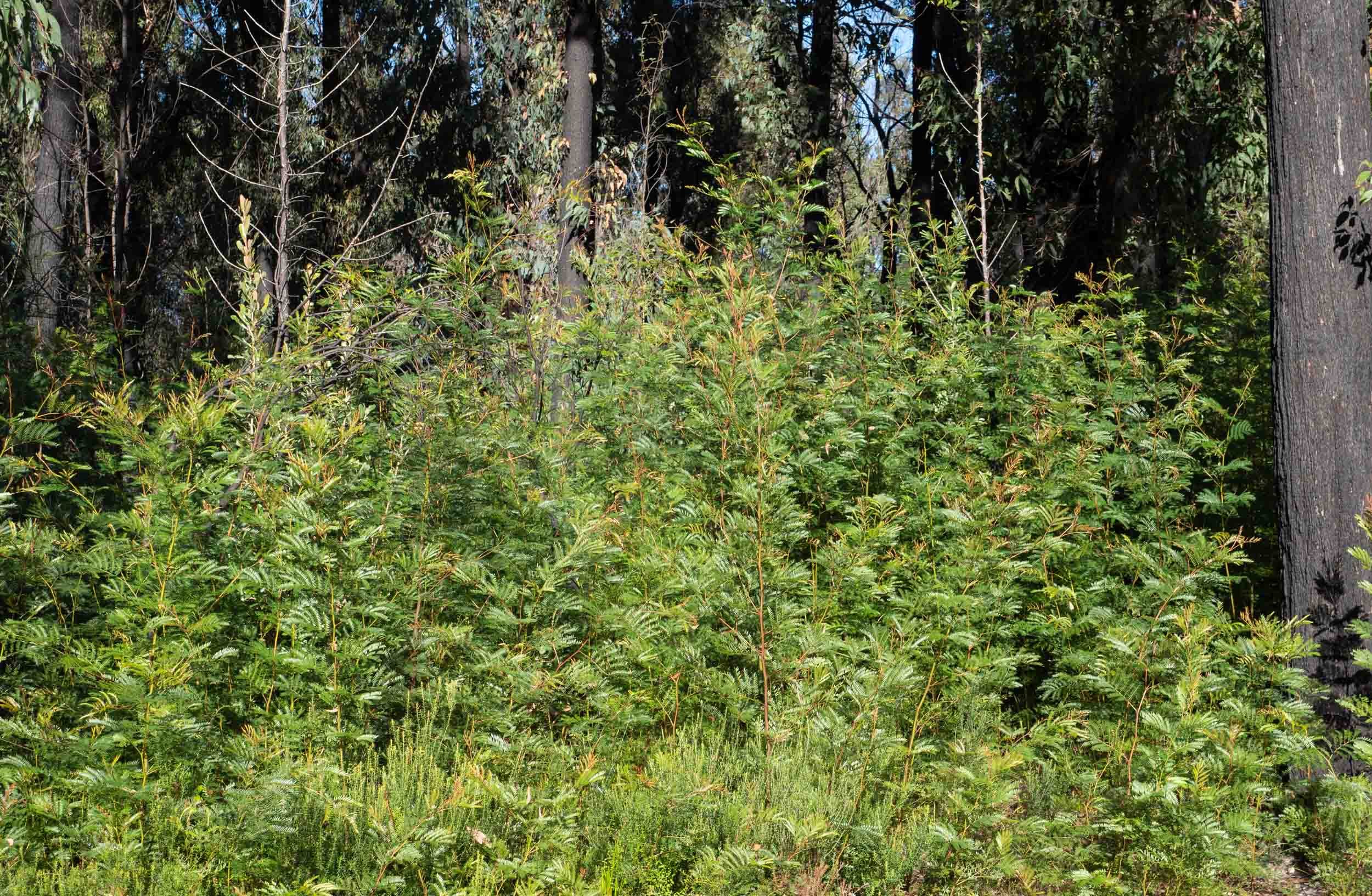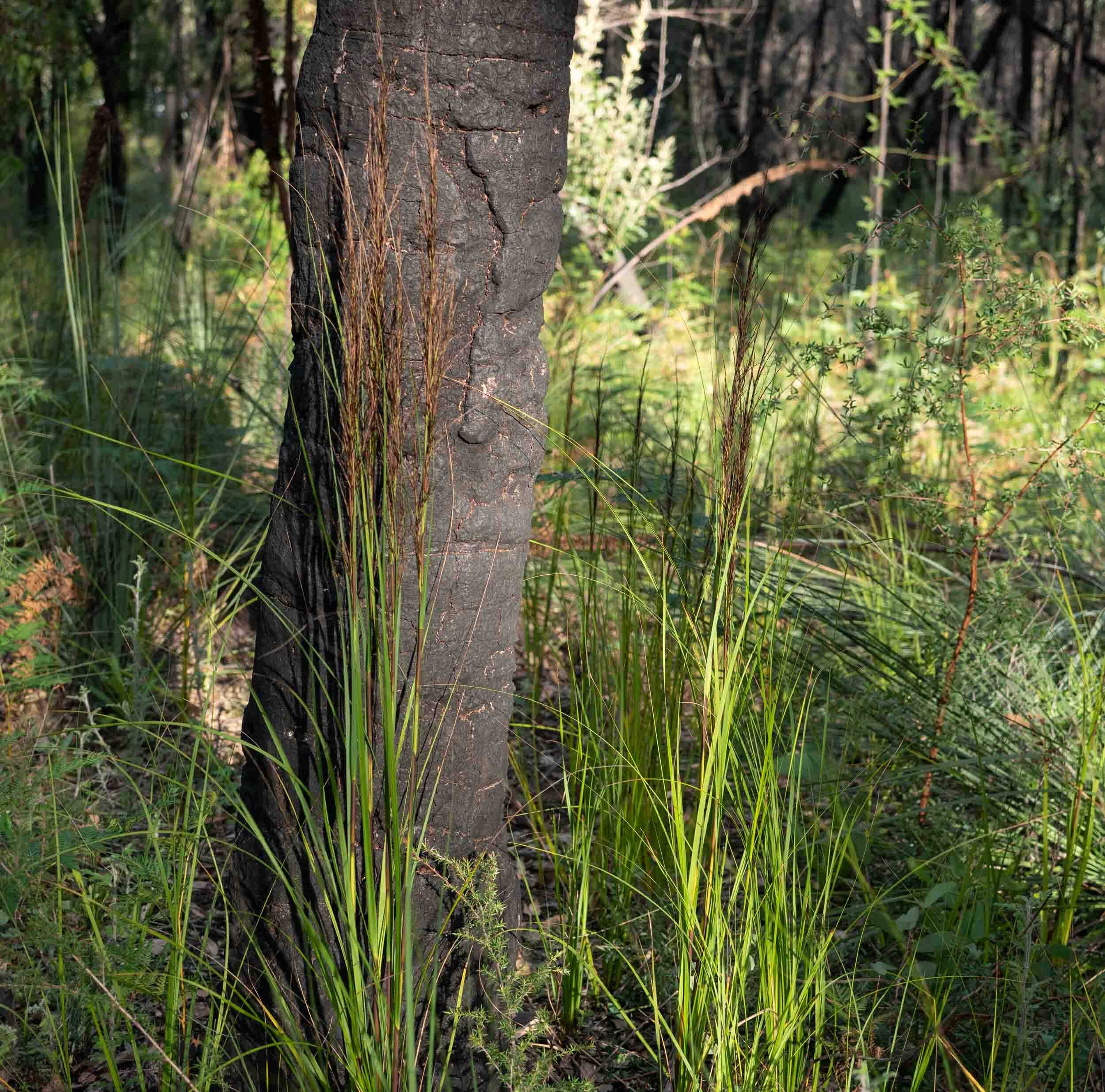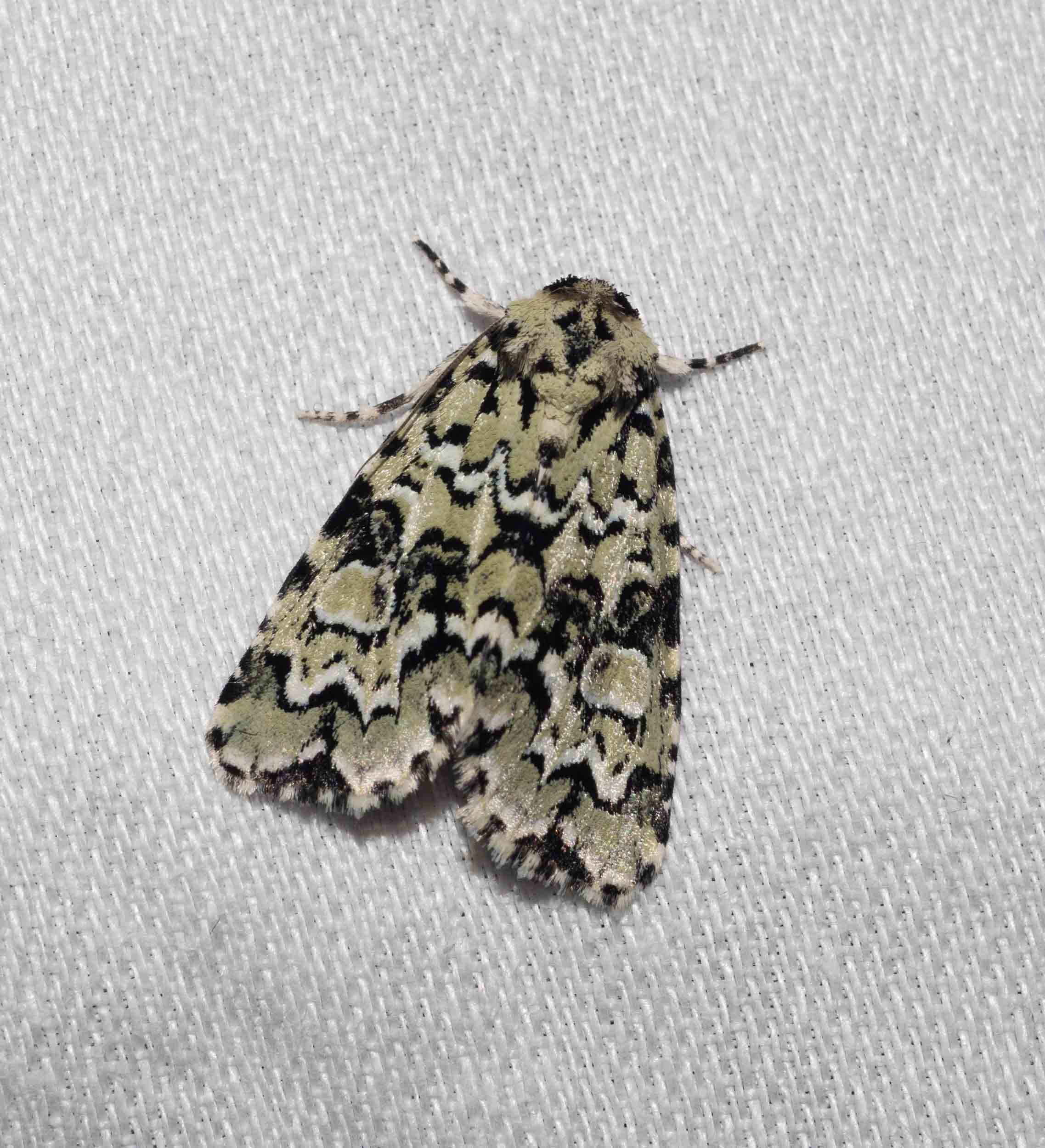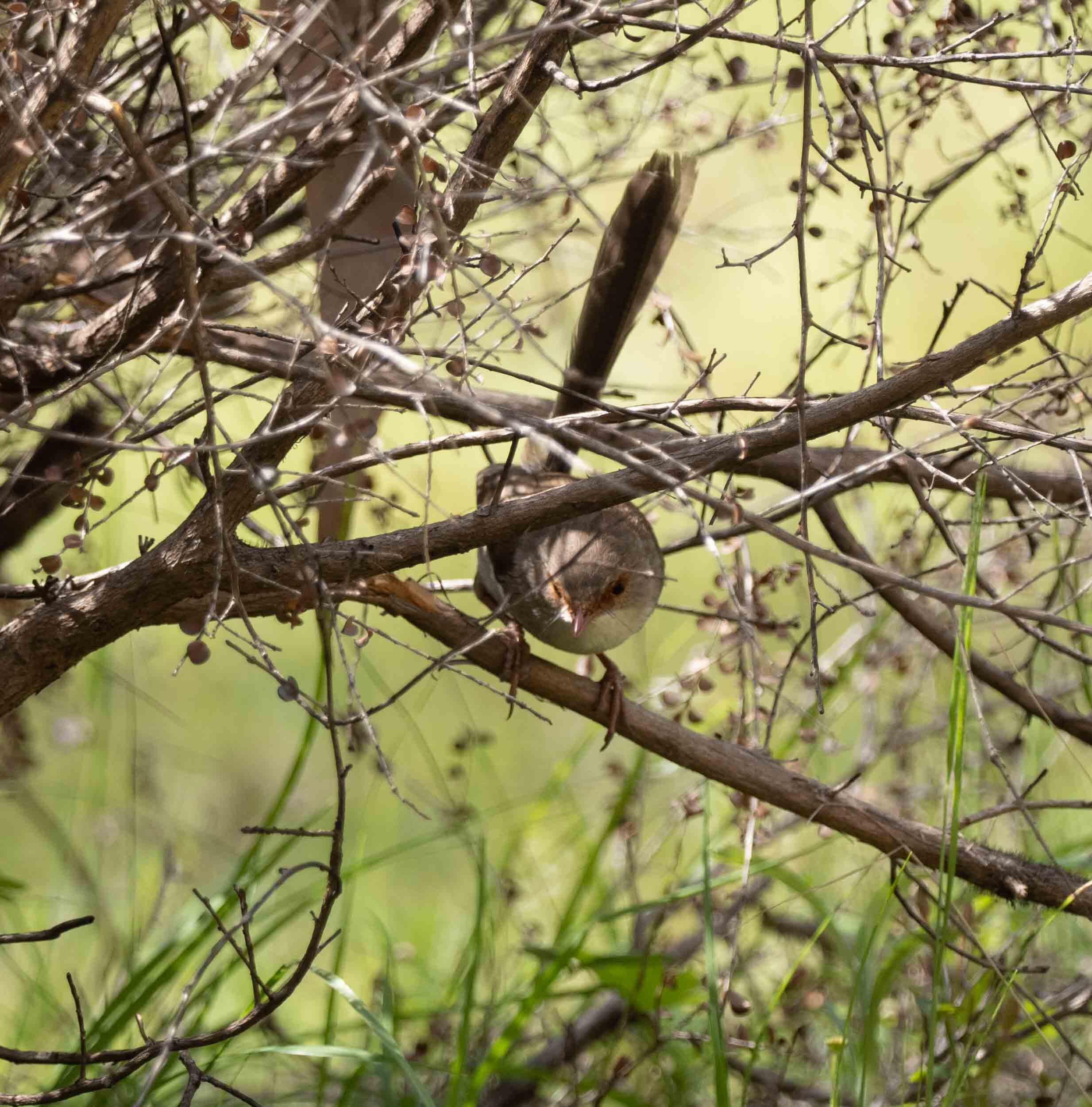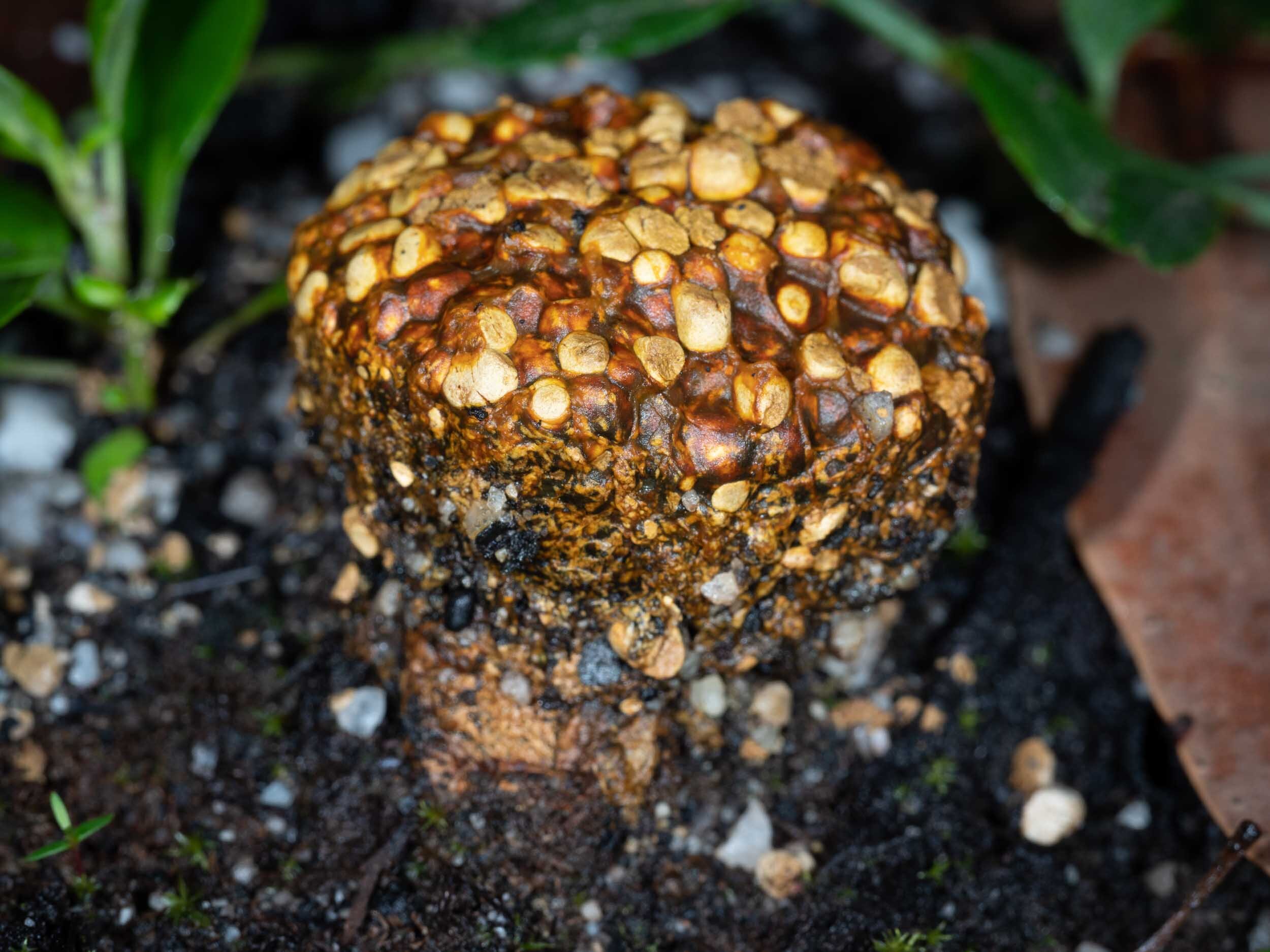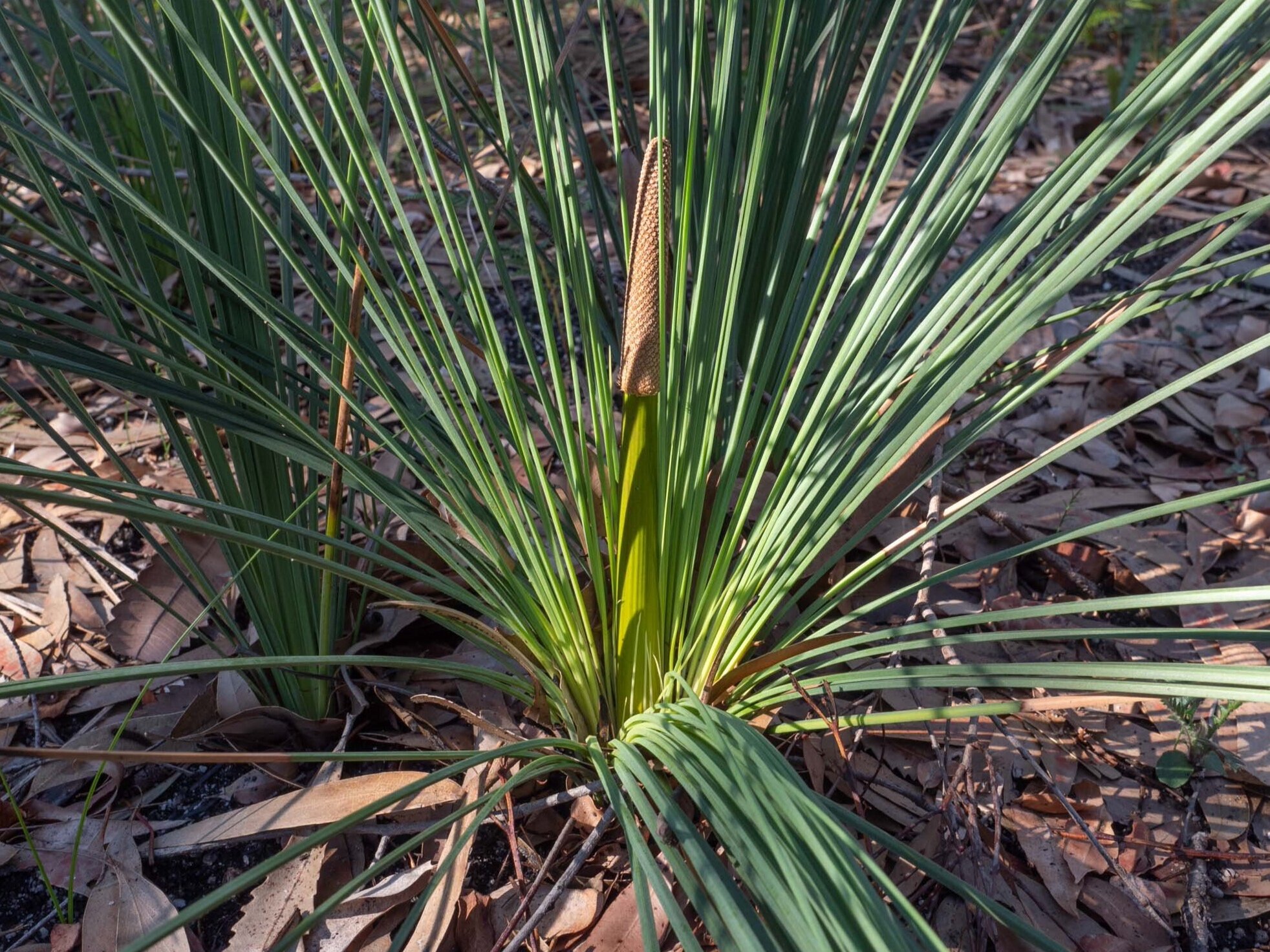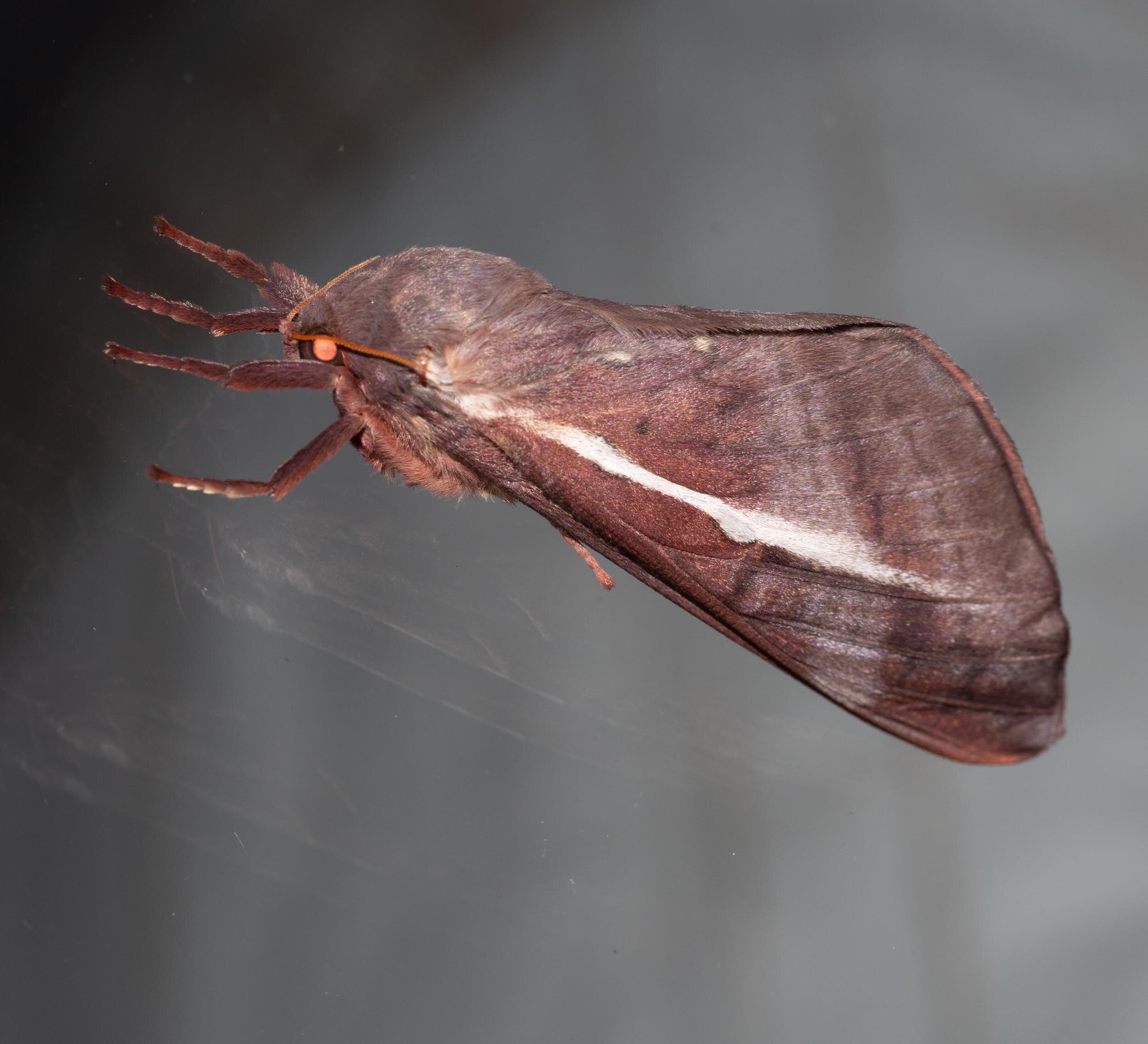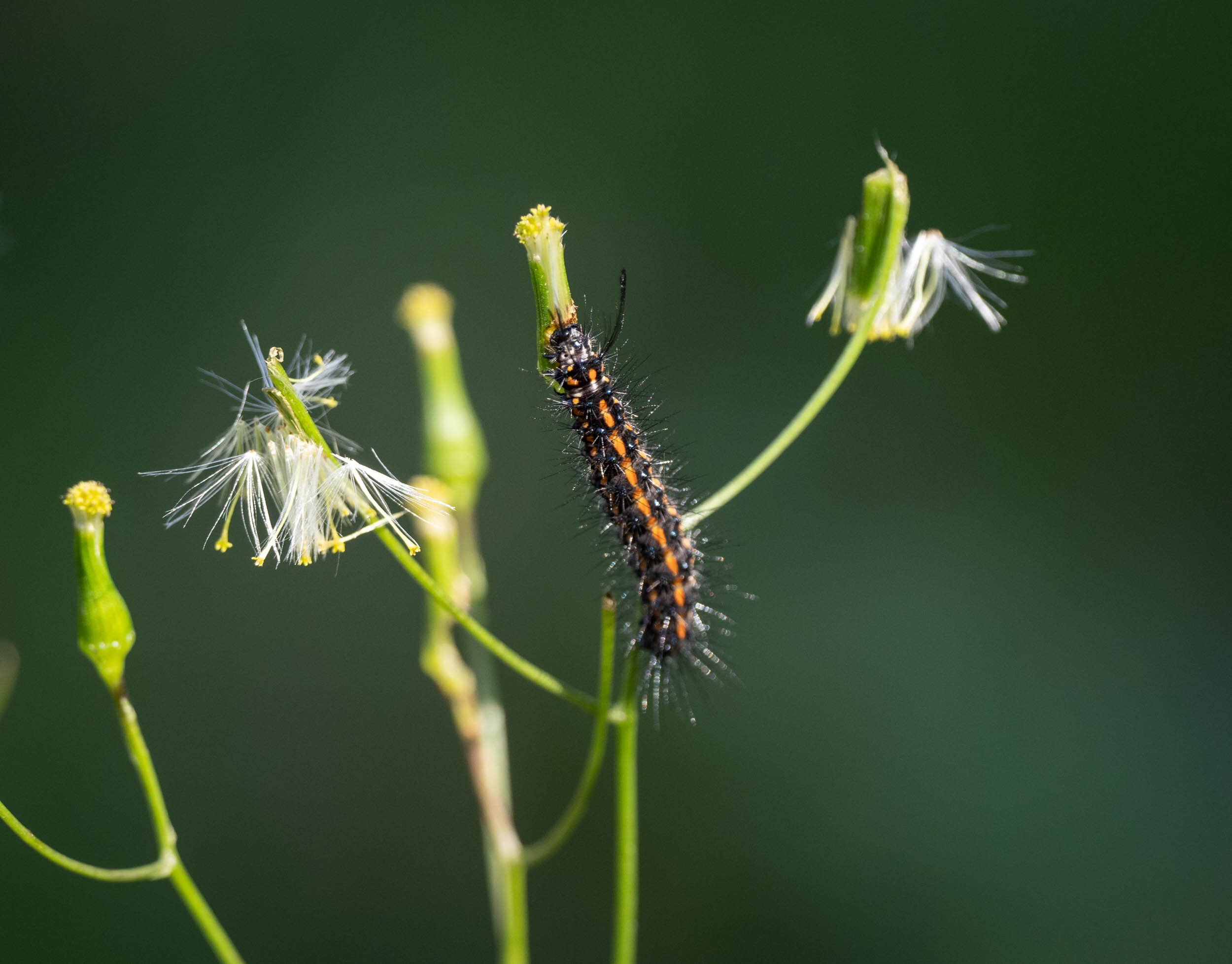Green renewal: an inventory
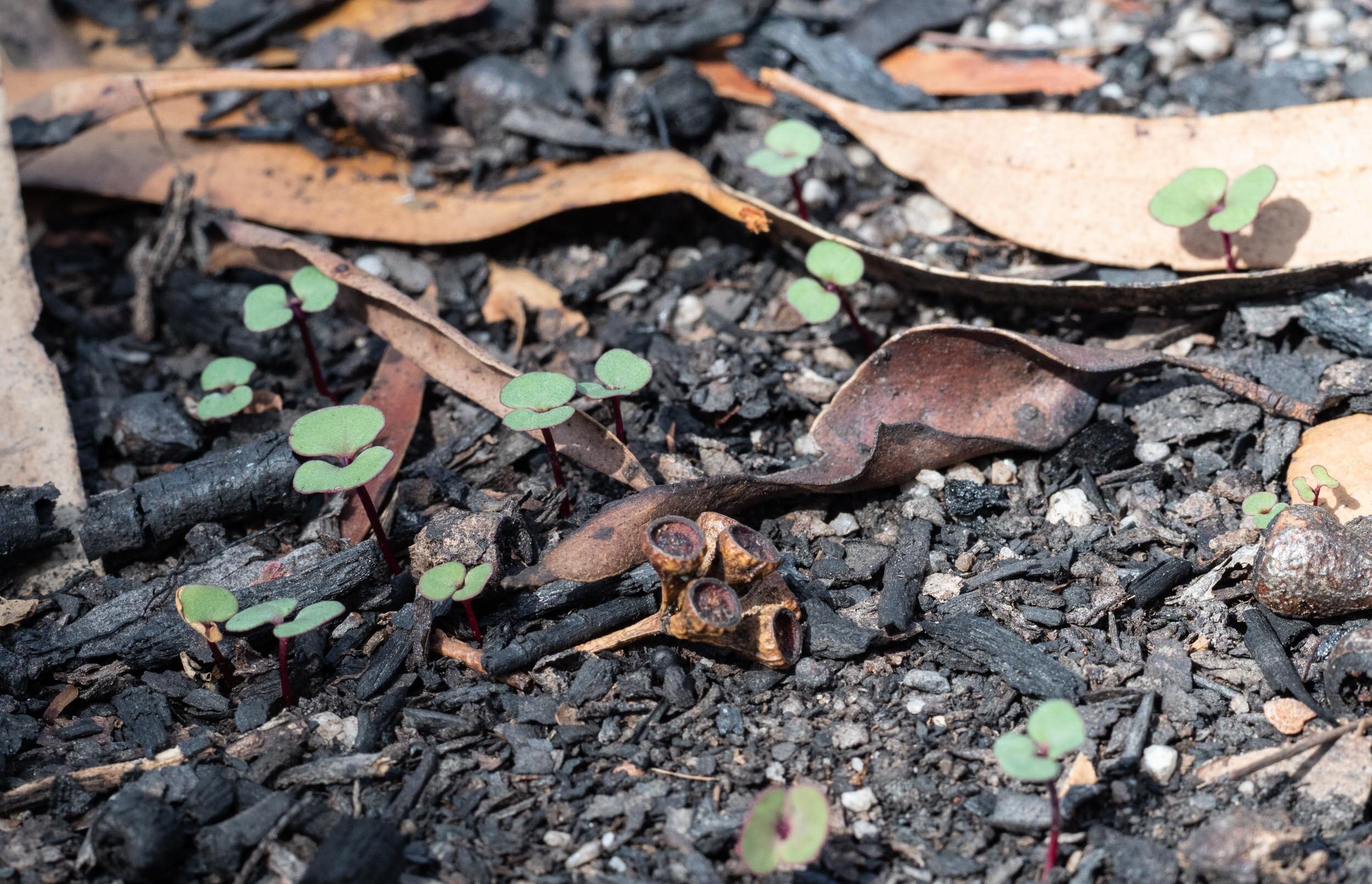
A lot has changed in the 3 weeks since my last post about the regrowth of our forest. It’s time for a stocktake.
I’ll touch on some of the same species as last time. But I aim to show how those and many new plants are gradually rebuilding the different layers of the forest - the canopy, middle storey and undergrowth.
A note at the outset. Most of the images in this post show either burnt plants in the process of regeneration or tiny seedlings. If you’d like to see the mature plants in their unburnt state, click on the headings and species names that are underlined.
The Tall Trees
Epicormic budding
There are obvious changes in the tall trees. All seven of our eucalypt species (Angophora floribunda, Eucalyptus globoidea, Eucalyptus cypellocarpa, Eucalyptus sieberi, Eucalyptus obliqua, Eucalyptus longifolia and Eucalyptus consideniana) have now taken on the strange fuzzy appearance I reported in my earlier blog - a result of the florid growth of foliage on their trunks and/or branches.
And almost all of the mature trees in the forest show this epicormic growth. That’s very reassuring as it indicates that they have survived the exposure to the intense heat and flames of the bushfire.
While these eucalypts look a bit bizarre now, they will in time adopt their familiar form as new branches develop at many of the sites of epicormic growth. The dead, burnt leaves in the canopy will be replaced by fresh ones on these new branches.
In the meantime, the clusters of leaves in “wrong” places are providing nourishment to both the tree (via photosynthesis) and the herbivorous insects that are gradually taking up residence on them. With time, the population of these insects will grow large enough to sustain the insectivorous birds that have been conspicuous by their absence since the fire.
Meristems - the secret to plant regeneration
Plants in general have incredible regenerative powers, which almost no animal can match. For this purpose they use meristems - clusters of stem cells located at either the tips of shoots and roots or on the sides of stems.
Cells divide within meristems in a tightly controlled pattern in space and time. The daughter cells go on to differentiate into various tissue types within leaves, roots, stems and flowers. Ongoing meristem activity is necessary to enable a plant to continue its normal growth and development.
Some plants, including eucalypts, have quiescent or inactive meristems in their trunks or in the root crown. These are activated following fire, producing those leafy epicormic buds or new plant stems.
Plants can also make meristems where they previously didn’t exist. For example, differentiated vascular cells in a root, which don’t normally divide, can transform into stem cells following injury to the plant. These new meristems can produce a sprout that goes on to become an entire new plant.
Of course, if the whole plant is killed by fire, none of the above can occur. In this case the plant can only continue existence if it has produced seeds and those seeds germinate to produce a new seedling.
Replacement of eucalypt trees by seedlings
We did lose quite a number of tall eucalypts during the fire, many of which burnt away completely, leaving white streaks on the black, ash-covered soil.
But replacements are on the way! In some spots, the forest floor is dotted with young eucalypt seedlings. Our botany guru and friend Jackie Miles identified these tiny plants when she and her partner Max Campbell joined us on a tour of the block on Feb 27. I thank her for the identification of many of the species we saw on that day (but any errors in this post are mine alone!).
The fire triggered a massive drop of seeds from the fruit (nuts) of the eucalypt trees. Some of these seeds were eaten by Peaceful Doves, Wonga Pigeons and Bronzewing Pigeons which we often saw loitering with intent on the forest floor in the first few weeks after the fire.
However, many seeds were missed by the pigeons and these germinated in the thick carpet of ash on the forest floor. The continued growth of the seedlings is sustained by nutrients in that ash. I find these tiny eucalypt seedlings with their pair of cotyledons quite wondrous. From little things…
Regrowth of eucalypts by rootstock sprouting
Some of our eucalypts are regenerating by sprouting from the roots of young saplings. This regrowth is very similar in appearance to the epicormic growth of the same species, as shown by this Angophora pair. Not surprising, I guess.
Loss of a giant
Sadly, one of the tallest trees in the forest - a magnificent 40 metre high Port Jackson Pine (Callitris rhomboidea) - is unlikely to survive. The tree shows no signs of regeneration two months after the Border Fire.
Lunt et al (2011) note that “Callitris are often killed by fire and usually do not resprout after being subjected to 100% leaf scorch”.
So the numerous small to medium sized Callitris saplings in the forest will also have been killed. We’re hoping that Callitris seeds dropped after the fire will successfully germinate and replace those burnt trees in time.
The middle storey
While the forest is dominated by the tall eucalypt trees, it also has a well-developed diverse middle storey of smaller trees and large bushes.
The main species in that layer are Black She-oak (Allocasuarina littoralis), Saw Banksia (Banksia serrata), Willow Needlewood (Hakea macreana) and several medium-tall wattle species.
In my previous post I mentioned the Banksia. But how are the others faring two months on?
Hakea macreana
As yet the Hakea bushes show no signs of sprouting.
We’ve read that Hakeas don’t survive a high intensity fire. But we’re hoping that some of the seeds survived.
These would have fallen to the ground after the fruit opened following the fire.
Empty Hakea macreana fruit after the fire
Allocasuarina littoralis
The casuarinas also show no signs of sprouting. Smaller plants of this species have been reported to resprout from the base 4 months after a high intensity fire. So we’ll see.
You might recall from an earlier post of Kerri’s that the fruit (cones) on the burnt Allocasuarina trees still held their seeds as late as three weeks after the fire. Large flocks of Rainbow Lorikeets were taking advantage of this food source until early February, when it appeared that most of the fruit was empty.
It seems that the Rainbows didn’t get away with all of the seeds. On our walk with Jackie on Feb 27 we discovered that swathes of the forest floor were covered in young Allocasuarina seedlings. We’d never have recognised them as such but Jackie picked them straightaway.
So it looks like we’ll have a casuarina forest in a couple of years. A bit of “weeding” might be called for!
Banksia serrata
Three weeks ago I was excited to discover the first signs of epicormic budding on one of our Banksia trees.
My excitement was tempered initially as for a week thereafter that I saw no similar signs on any of our other trees. I was beginning to think that this one tree was resprouting only because it had been spared the full onslaught of the fire.
Then a week ago I noticed that several of our small trees had epicormic buds. These are now going gangbusters!
Many of the larger trees also have buds. This includes some trees that fell several years ago but that have continued to grow because their roots are still anchored in the soil.
So we’re really confident that our Banksia grove will be reborn from the ashes!
Like the eucalypts, the Banksias are producing seedlings as well as epicormic buds in response to the fire. Again Jackie pointed these out to us on our walk through the forest.
It appears germination of the seeds was a recent event as all of the seedlings we saw on Feb 27 were quite young.
Two months since the fire and many of the Banksia cones still have seeds in them. So we can expect many more seedlings to germinate in the forest floor as they progressively fall from the cones.
But not all seeds will make it that far.
A flock of a dozen Yellow-tailed Black Cockatoos descended on our back gully today and proceeded to help themselves to an easy feed of Banksia seeds. “Easy” because the birds normally have to pry the closed follicles open to gain access to the seed within. The heat from the fire has caused all of the follicles to open, allowing the birds to delicately pick out each seed with no effort at all.
You can find an excellent account of the various ways that Banksia plants respond to fire here.
Acacia implexa (Hickory), March 4
Only one of the larger wattle species has shown signs of resprouting.
Acacia implexa (Hickory), a five metre high tree, showed exuberant epicormic budding six weeks after the fire and now has abundant foliage.
A smaller wattle species, Acacia verticillata (Prickly Moses), is resprouting from rootstock.
Many wattle seedlings have sprung up since the fire, but in most cases it is difficult to identify the species with confidence as most are at an early stage of growth.
Here are three seedlings whose identity I feel reasonably confident about. Note how the first leaves of the seedling are bipinnate in all three species. This is retained in the mature leaves of Acacia mearnsii but later changes to the simple leaf shape in the other species.
Other larger shrubs
Geebungs
A distinctive large shrub of the forest - Persoonia linearis (Narrow-leaved Geebung) - has survived the fire well, by exuberant epicormic sprouting from the trunk and branches. The first buds appeared in early February.
Now, at two months after the fire, almost all of these shrubs, both large and small, show abundant leaf growth.
In the last few days, the related species Persoonia levis (Broad-leaved Geebung) has begun to bud as well.
You’d be excused for thinking that the flaky, charred appearance of the bark on these plants is the result of fire damage. In fact, this is what the bark normally looks like on geebungs.
Persoonia is also doing the “regenerate from seed” trick.
Teatrees
Only one of our teatree bushes shows signs of sprouting on the main body of the plant.
This large Kunzea ericoides (Burgan) bush apparently escaped the most intense heat of the fire. That area was shielded to some degree by our garage.
Its inner branches started to produce new foliage a month after the fire.
Looks like it will be back to normal before long!
Other bushes of this species weren’t so lucky. All that remained of a cluster on the verge facing the road were black sticks.
However most of these plants are resprouting from the rootstock, which was protected from the heat of the flames by a layer of soil.
Several other teatrees - Leptospermum continentale (Prickly Teatree), Leptospermum brevipes (Slender Teatree) and Sannantha plurifolora (Twiggy Heath-myrtle) - show the same sprouting response.
Lance Beard-heath
Leucopogon affinis is a medium-sized bush which is widespread in open areas of the forest.
All plants were burnt to blackened sticks but, as I mentioned in my earlier post, many are regenerating vigorously by rootstock sprouting.
We were very pleased to see this as Leucopogon affinis plays a key role in the ecology of the forest. It flowers profusely from August to October, attracting many different insects. Its fruit, a round, red berry is avidly eaten by several different bird species.
Other bushes
At least five other medium-sized bushes - Ozothamnus obcordatus major (Grey Everlasting), Indigofera australis (Austral Indigo), Elaeocarpus reticulatus (Blueberry Ash), Callistemon citrinus and Banksia spinulosa (Hairpin Banksia) - are regenerating by sprouting from the rootstock. I showed photos of all of these except for the Grey Everlasting and the Blueberry Ash in my earlier post.
Another bush, Dodonaea triquetra (Large-leaf Hopbush) is not yet sprouting, but has produced many seedlings.
These are much more widespread than the adult bushes, suggesting that fire stimulates this species to germinate.
We’ve seen the same phenomenon for several other regenerating species.
It will be interesting to see how many of these seedlings survive.
Dodonaea triquetra seedlings, Feb 29
Several middle-storey plants have not yet shown signs of regeneration either by sprouting or seedling growth. These include Monotoca elliptica (Tree Broom-heath), Kunzea ambigua (Tick Bush), Melaleuca armillaris (Giant Honey-myrtle) and Beyeria lasciocarpa (Wallaby Bush).
Of course, there is still time! We’ll keep checking the burnt bushes and nearby ground for seedlings of these species.
Middle storey summary
The picture is very positive when looking at regeneration of small trees and medium-large bushes. The large majority of these species are showing clear signs of recovery from the damage inflicted by the fire.
However, it is also clear that it will be some time - months and in some cases years - before most of these plants resemble what they looked like before the fire. With a few exceptions - geebungs and banksias, which display epicormic sprouting on their trunks and upper branches - these mid-storey plants are currently just part of the undergrowth. The insect and bird species that depend upon the foliage, flowers and fruit in the middle storey will only be irregular visitors till it fully regrows.
Let’s now turn to the undergrowth.
The undergrowth - a rapid transformation
When I look across the forest now and compare it to what it looked like before and immediately after the fire, I see clear differences.
What’s missing in both of the post-fire photos below is the middle storey. All that remains of that layer are the black sticks of the bushes. This will change, but not quickly.
What has radically changed in recent weeks is the undergrowth. The forest floor is now covered with low, green plants. It looks like parkland, rather than forest.
But that impression would be wrong. Parklands are relatively depauperate, whereas the undergrowth in the March 5 photo is highly diverse. You are looking at dozens of plant species in that scene - grasses, sedges, ferns and forbs - and much of the forest has undergone a similar transformation.
To get an idea of this diversity, look through this gallery of images we’ve taken in the two months since the fire. I haven’t included all regenerating species and I’ve omitted most of those that got a guernsey in my earlier post.
But this spreadsheet lists all our home plant species, whether and when we’ve seen regeneration of it to date and how it regenerates - by seedling or sprouting. A blank entry in the First Regeneration cell indicates either that this species hasn’t been seen since the fire or it hasn’t shown any signs of regeneration.
Note that there are blanks for all of the orchids, except for Dendrobium speciosum. However, we’re expecting some interesting sightings in the Spring as several species of orchids are stimulated to flower by fire.
We drew heavily on Jackie’s experience and knowledge to identify the following regenerating species. Bear in mind that some of these identifications are provisional, particularly when seedlings are at an early stage of growth.
If you’d like to see what each of these plants looks like in the adult stage, go to the Atlas of Life NatureMapr website. Enter the name of the plant in the Quick Search box on the top right hand corner of the screen, click on the name when it appears in the drop-down box below and you’ll be taken to the page for that species. Click on any thumbnail to see a full-sized image.
The Rainbow Fern saga - an update
You may recall from my earlier post that Rainbow Fern (Calochlaena dubia) started to regenerate about a week after Bracken (Pteridium esculentum) which itself was one of the earliest plants out of the blocks.
I wondered whether the previously dense stands of Rainbow Fern would return or whether it would be outcompeted by Bracken.
I’m pleased to report that the Rainbow Fern thickets are back in all their previous glory. The Superb Fairy Wrens, White-browed Scrubwrens and Brown Thornbills will be just as happy as I am.
Rainbow Fern thicket, March 2
A wrap-up
Two months after a cataclysmic event that we always assumed would occur - but which we feared for its potential impact on our forest - we’re feeling very positive.
In the short space of time since the fire, we’ve seen signs of regeneration in 55% of our home plant species. That represents 131 species, only 8 of which are introduced weeds. Click on this button to see the details:
Yes, what the forest looks like in a year or two’s time will probably be quite different to what it looked like before the fire. But that doesn’t make it any less interesting or precious. Ecosystems are by their very nature dynamic and ever-changing. I like change.
In hindsight we shouldn’t have been so anxious about the fire. The Australian continent is a dry place - has been for milllions of years - and nature has evolved in a myriad of ways to deal with that. It is resilient.
That resilience will be sorely tested in coming decades in the face of rapid, human-induced climate change.
References
Lunt, I.D., Zimmer, H.C. and Cheal, D.C. (2011) “The tortoise and the hare? Post-fire regeneration in mixed Eucalyptus-Callitris forest.” Australian Journal of Botany 59: 575-581.



